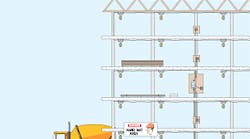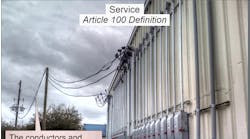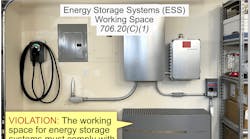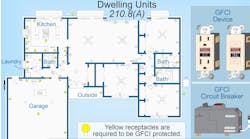Making Temporary Installations Safe for All Trades
James Bond has a license to kill. Sometimes, temporary installations look like something rigged up under that same license. The NEC not only helps to ensure the safety of the end-user, but it also protects all the trades working on a project that employs temporary electrical installations.
Many people might think of the electrical inspector as the authority having jurisdiction (AHJ), but the inspector isn't the only AHJ on a given job. If a project is in progress and using temporary power or light, the general contractor and OSHA can also enforce temporary installation rules. The insurance providers of parties like your company, the general contractor, other trades, and the property owner can also get involved.
The requirements of Art. 527 apply to all temporary power and lighting installations, including power for construction, remodeling, maintenance, repair, demolitions, and decorative lighting. They also apply when temporary installations are necessary during emergencies or for tests and experiments. All the requirements apply to temporary installations unless specifically noted in Art. 527.
Certain venues have additional requirements. Temporary installations for trade shows must comply with Art. 518. Temporary installations for carnivals, circuses, fairs, and similar events must comply with Art. 525.
Time constraints.
Temporary installation rules do provide some savings in cost and time when compared to permanent rules. At one time, electricians would install temporary power or lighting under those looser Code requirements, and installations would be “temporary” on a permanent basis. As a result, time constraints made their way into the NEC and are defined as follows:
- Construction period
You can use temporary electrical power and lighting installations during the period of construction, remodeling, maintenance, repair, or demolition of buildings, structures, equipment, or similar activities.
- Decorative lighting
You can use temporary electrical power for decorative lighting for 90 days.
- Emergencies and tests
You can use temporary electrical power and lighting installations for the duration necessary for emergencies or for tests and experiments.
You must remove all temporary installations immediately upon completion of the purpose for which they were installed.
- Services
You must install a service per Art. 230. You must treat a service as permanent, even if it's temporary.
- Feeders
You can't use open conductors for temporary feeder installations. Instead, you can use cable assemblies, hard-usage cords, extra-hard usage cords, and NM cable. However, you can use individual open conductors for feeders where the individual open conductors are accessible only to qualified personnel.
- Branch circuits
You can't use open branch-circuit conductors, such as “festoon lighting,” for temporary installations. Instead, you can use cable assemblies, hard-usage cords, extra-hard usage cords, and NM cables (Fig. 1). However, you can use open wiring for branch circuits in holiday decorative lighting if the circuit voltage-to-ground doesn't exceed 150V, the conductors aren't subjected to physical damage, and the conductors are supported on insulators at not more than 10-ft intervals.
- Receptacles
Receptacles must be of the grounding type and the equipment grounding (bonding) terminal of the receptacle must be grounded (bonded) to an equipment grounding conductor (250.118), in accordance with 250.146. This doesn't mean driving a ground rod and bonding to it without bonding to the rest of the system. Remember, electricity always seeks to get back to the source, not to the earth.
- Lighting vs receptacles
On a construction site, you need to put the lighting and receptacles on separate circuits to prevent the lights from going out if the GFCI opens. The same principle applies where you're using a multiwire circuit. Put lighting on one circuit and receptacles on the other.
- Disconnecting means
All ungrounded circuit conductors must have a disconnecting means, such as a switch or circuit breaker. Ungrounded circuit conductors of a multiwire branch circuit need a disconnecting means at the panelboard, and it must open all of the ungrounded conductors simultaneously. If the multiwire circuit uses single-pole circuit breakers, you must use an approved handle tie to secure the trip handles together. For additional requirements for multiwire branch circuits, see 210.4 and 300.13(B).
- Lamp protection
You must protect lamps from accidental contact by using a suitable luminaire or a lampholder with a guard.
- Splices
On construction sites, you don't have to put splices of cords or nonmetallic cables in boxes. However, this doesn't mean you can use “twist and tape” or other unapproved methods for making those splices. You must use methods and devices suitable for the purpose.
- Protection from accidental damage
You must protect cables and flexible cords from accidental damage, sharp corners, and projections. You must also provide protection for cables and flexible cords when passing them through doorways or other pinch points.
- Terminations at devices
Cables and flexible cords that enter enclosures must be secured to the enclosure with fittings designed for the purpose. You can't just stick them through an opening in an enclosure. The intent is to prevent stress on cables and cable terminations.
- Support
Make sure you support cables, cable assemblies, and flexible cords at intervals that ensure protection from physical damage. To provide this support, use staples, cable ties, straps, or other similar products that won't damage the cable or cord assembly. The AHJ can make specific cable support requirements based on jobsite conditions. Per 230.10, you can't use trees or other vegetation for support of overhead spans of branch circuits or feeders.
-
All 15A, 20A, and 30A 125V receptacles used for temporary power must have GFCI protection. You can provide GFCI protection via circuit breakers, receptacles, cord sets, or other devices, such as GFCI adapters that incorporate listed GFCI protection (Fig. 2).
-
You must provide GFCI protection for receptacles that are part of the permanent wiring of the building and used for temporary power (Fig. 3). However, GFCI protection isn't necessary for receptacles located in industrial establishments that are only qualified personnel are involved in maintenance and follow an assured equipment grounding conductor program (AEGCP).
-
Receptacles rated other than 15A, 20A, or 30A 125V that supply temporary power to equipment used by personnel during construction, remodeling, maintenance, repair, or demolition of buildings, structures, equipment, or similar activities must comply with GFCI protection or an AEGCP (Fig. 4). You can use GFCI protection and an AEGCP on the same job — they aren't mutually exclusive.
AEGCP.
An AEGCP requires grounding tests of cord sets, receptacles, and cord-and-plug connected equipment. You also must test all equipment grounding conductors for continuity. Each receptacle and attachment plug must be tested for the correct attachment of the equipment grounding conductor. Record the results of these tests and make them available to the AHJ. The tests must be performed:
-
Before the first on-site use.
-
When there's evidence of damage.
-
Before equipment is returned to service following repairs.
-
At least once every three months.
Guarding.
For wiring over 600V nominal, you must provide suitable fencing, barriers, or other effective means to limit access to only qualified personnel. Common sense and/or the AHJ may also require such guarding for lower voltages, based on jobsite conditions.
The requirements for temporary installations can be summed up rather simply. First they must be truly temporary. Service entrances have no temporary allowances. Other applications allow you to use cords and cable assemblies rather than installing raceways, and they allow you to place splices outside of boxes. But there's a trade-off. You must also provide the additional protection of a GFCI or AEGCP. In addition to satisfying the AHJ, you ensure your own safety when your temporary installation conforms to Art. 527.
Are you still confused by the Code? For additional information on Code-related topics please visit www.mikeholt.com or send an e-mail directly to the author at [email protected].




